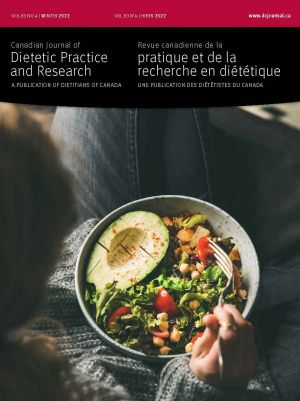Volume 70 • Number 3 • September 2009
Chair’s Message
Editor’s Message
Research
Purpose: A qualitative assessment was completed of overweight/ obese youths’ perceptions of the meaning of “healthy body weight,” barriers and facilitators to healthy body weight attainment, and what would effectively enhance and support their healthy body weight behaviours. Methods: This qualitative study targeted a sample of overweight and obese youth, aged 14 to 16 years. An experienced interviewer conducted 11 in-depth interviews. Interviews were audio-recorded and transcribed verbatim. Three qualitative researchers conducted independent and simultaneous inductive content analysis to facilitate confirmability. Data trustworthiness was supported viamember checking, peer debriefing, and reflexive journalling. Results:Most participants characterized healthy body weight as a combination of healthy eating and regular physical activity. Some included a psychological dimension in the definition. Perceived facilitators of a healthy body weight included family support, access to nutritious food at home, physical activity encouragement, and a physical activity environment at school. Perceived barriers included lack of family support, a poor nutrition environment, an unsupportive school environment, time, self-esteem, and bullying. Participants identified preferences for an intervention that would include opportunities for unstructured coeducational recreational activities, coeducational nutrition education sessions, and a gender-specific discussion forum. Conclusions: Participants provided a wealth of information to form the foundation of future youth-focused efficacious healthy body weight interventions.
Purpose: Family meals have been associated with improved dietary quality in children and adolescents, and yet very little is known about family meals beyond their frequency. Specific aspects of the breakfast, lunch, and dinner meal environments were described and compared, and the associations with overall diet quality were investigated. Methods: Data on food intake andmeal environments were obtained in northern Ontario, southern Ontario, and Nova Scotia grades six, seven, and eight classrooms over the 2005 to 2006 school year. Specific aspects of themeal environments described were where themeal was consumed, with whomparticipants consumed eachmeal, who prepared themeal, and where the food was originally purchased. Diet quality was assessed using the Canadian version of the Healthy Eating Index. Cluster K-means procedures were used to classify into groups observations about the fourmeal environment variables. Results: Three, eight, and six clusters of meal environments were identified for breakfast, lunch, and dinner, respectively. Diet quality was negatively associated with consuming/purchasing meals outside the home, and with skipping breakfast, lunch, and/or dinner. Conclusions: Results have immediate relevance for familybased and/or school programs and policies aimed at educating and feeding children and adolescents.
Purpose: Pre-conception weight gain and postpartum weight retention may contribute to women’s increased risk of developing overweight/obesity; however, weight history data that would permit an examination of this hypothesis have been lacking. Our objective was to describe the weight history of pregnant overweight women and their families. Methods: Between 16 and 20 weeks of gestation, 107 overweight pregnant women (21 Aboriginal, including 20 First Nations and oneMétis, and 86 non-Aboriginal) completed a weight history questionnaire. Results: Average adult usual body weight (UBW) corresponded to a bodymass index (BMI) of 29.2 ± 5.5 kg/m2 (overweight). Average pre-pregnancy BMI (33.0 ± 6.6 kg/m2) increased into the obesity category.Over two-thirds of subjects reported an unstable UBW. A large proportion ofmultiparous subjects had retained weight after pregnancy. The average weight retained was 12.7 ± 9.4 kg, and it accounted for almost all of the weight change from UBW. Conclusions: Weight history questionnaire results showed that pre-conception weight fluctuations and postpartum weight retention are significant problems for many overweight/ obese women. Health care professionals can use this information for early prenatal through postpartum interventions designed to help overweight/obese women achieve an appropriate pregnancy weight and prevent sustained postpartum weight retention.
Purpose: Infant age at introduction of solid foods was examined, as were maternal characteristics associated with adherence to recommendations. Methods: In a telephone survey, 2153mothers living in Ontario were asked questions about the age at which foods were introduced to their infants. Results: Eighteen percent of respondents introduced infant cereal before age four months, while 5% introduced it at age seven months or later. Mothers who introduced cereal either earlier or later than recommended had a lower household income and were less likely to have attended prenatal classes than were those who followed recommendations. Mothers who introduced cereal before their infants were four months old were more likely than were other mothers to be younger, not to be breastfeeding at three months, to have smoked during pregnancy, and to have someone who smoked inside the home. Mothers who introduced infant cereal after age seven months were more likely to be older, breastfeeding at three months, and mothering their second or later-born child than were mothers who introduced infant cereal as recommended. Conclusions: Small but distinct groups of mothers are introducing solid foods earlier or later than recommended. Educational and informational initiatives that target these parents may help increase the number of infants being fed as recommended.
Purpose: Elderly people are at risk for malnutrition, and those who consume a puréed diet may be particularly at risk. A fortification procedure was developed at a long-term care (LTC) facility, and nutrient intakes and serum vitamin levels were assessed to determine whether they subsequently increased. Methods: Fortification levels were determined using a combination of two techniques: the Dietary Reference Intakes planning formula and Health Canada’s defined nutrient contribution method. For six puréed foods, triangle sensory tests were performed to determine whether fortification changed the flavour of the foods. Four fortified foods were incorporated into the daily puréedmenu at an LTC facility. Nutrient intakes of 10 residents and serumvitamin B12, folate, and 25-hydroxyvitamin D levels of 11 residents were analyzed at baseline and eight weeks after the intervention. Results: Nutrient intakes increased after the intervention for all nutrients in the fortification mix (p<0.01). 25-hydroxyvitamin D and folate levels increased after the intervention (p<0.01), but serum vitamin B12 levels did not change (p>0.05). Conclusions: The development of acceptable vitaminfortified puréed foods is feasible and is an effective way to increase the micronutrient status of LTC residents. Mineral fortification requires further work to minimize flavour changes.
Report
Objectif: Étudier l’association entre la pneumonie d’aspiration (PA) et la dénutrition chez des patients d’unités gériatriques actives (UGA) et décrire le profil des patients ayant développé une PA. Méthodes: Les cas de PA ont été repérés parmi les patients radiés de deux UGA entre 2001 et 2007 (n=2238). La prévalence des atteintes neurologiques, de la dysphagie et de la dénutrition a été comparée chez les patients selon qu’ils aient développé ou non une PA. Le profil des cas de PA a été déterminé à partir des dossiersmédicaux. Résultats: L’incidence cumulée des PA est faible dans les deux unités (1,1%). La PA était fortement associée aux atteintes neurologiques (accident vasculaire cérébral etmaladie de Parkinson) et à la dysphagie (p<0,01), et tendait à être plus prévalente parmi les patients dénutris (p<0,10). Selon l’évaluation diététique, environ 80%des cas de PA étaient dénutris, résultat appuyé par une prévalence élevée d’indicateurs du risque nutritionnel. Conclusions: Les résultats obtenus soutiennent l’hypothèse d’un rôle possible de la dénutrition dans le développement des PA chez les patients âgés hospitalisés. La prévention et la prise en charge de la dénutrition, particulièrement chez les personnes dysphagiques, pourraient contribuer à la prévention des PA dans cette population.
Recognition
OPEN ACCESS
Ask any Olympian about their quest for gold and they will almost always tell you it’s not really about the gold–it’s all about the journey. What they learned and how they felt at the time of their successes, disappointments and failures is ultimately what challenged them to find the courage to truly believe in themselves and achieve their personal best. As dietitians, we are also like Olympians as each of us seeks personal success in our journey through life. It is no surprise that it takes knowledge and experience to become a champion. “Going for the Gold” highlights some of the milestones and challenges in the author’s career and focuses on (her) two specialties, sports nutrition and nutrition and infertility, both relatively new to the dietetics field. Having a successful private practice means building a solid foundation of knowledge, excellent clinical and communication skills, finding the courage to “think outside of the box”, a compassion for others and a strong work ethic to fulfill goals that benefit both clients and the profession. As the author recounts her journey, dietitians are reminded that there is no straight path to success, and in their quest for gold not to forget to give back…to their profession, their family, their country and their environment.
Canadian Foundation for Dietetic Research
OPEN ACCESS
Once again, the Dietitians of Canada (DC) national conference in Charlottetown provided an opportunity to showcase current research in dietetics and nutrition through the Canadian Dietetic Foundation for Dietetic Research (CFDR) Research Event. We had a large number of abstracts submitted this year, and included 24 oral presentations and 47 posters in the program. I was abstract editor 15 years ago when the DC conference was held in Charlottetown, and I was delighted to see the increased level of interest since then. It is critical for dietitians to be involved in research because it forms the framework and foundation for dietetics. We need to be the generators of the knowledge base for our profession, whether we are students, interns, collaborators, or principal investigators, and whether that knowledge is generated through measuring the impact of our practice, conducting basic research, or exploring the experiences and attitudes of those in our own profession. One of the most exciting things about research in nutrition and dietetics is the diversity of methods and approaches used. In fact, the abstracts included in the DC Conference 2009 are as diverse as our profession. Research presented will enhance our understanding of advances in nutrition education, national guidance, underlying mechanisms of chronic disease, and food service management, to name just a few areas. Settings also vary from public health to long-term care to university laboratories. Dietitians shared their “better practices” in such areas as nutrition screening and assessment, enhancing teaching and learning in undergraduate dietetic education and graduate studies, and health literacy and school nutrition. The “buzz” that these presentations and posters are sure to create will keep our profession vibrant and growing. On behalf of the membership of Dietitians of Canada, I would like to thank Dr. Candice Rideout and Kimberley Hernandez who, along with myself, constituted the small but hard-working Abstracts Review Committee. They not only gave up their time, they provided their expertise in judging a large number of abstracts. I would also like to thank the Canadian Foundation for Dietetic Research for its ongoing support of practice-based research in Canada. I am particularly grateful to Diana Sheh and Isla Horvath for shepherding us through the review process and the scheduling of presentations. Please join me in celebrating Canadian dietetic research represented in these abstracts of the poster sessions and oral abstract presentations from this year's CFDR Research Event.










